
Electrical Barrier
This, however, is no trivial exercise.

The electrical repulsion for protons one fermi apart is huge -- E ~ 2.5 x 10-13 Joules. For a gas to have particles with kinetic energies this large, the temperature must be 1.5 k T ~ 2.5 x 10-13 Joules or T ~ 17 billion Kelvin.
The key to this lies in some odd consequences of Quantum Mechanics. To get a feel for the effects, consider something known as the Heisenberg Uncertainty Principle.
So, what happens is this.

Particles cannot overcome the electrical repulsion (classically) because the electrical force (hill) is too large. However, a small fraction of the time, particles can tunnel through the barrier and appear close together so that the strong force can bind the particles together. The shorter the distance the particles have to tunnel (the closer they are to the top of the hill), the greater the probability that they will be able to tunnel. As a result of tunneling, enough nuclear reactions can take place in the core of the Sun at the low temperature of 15,000,000 Kelvin!
Hydrogen is the simplest element (1 proton), it has the weakest electrical charge and so has the weakest electrical barrier to fusion. Because of this, it is the first nuclear fuel to be used. Consequently, we know that the Sun is in the first stage of its nuclear fusion lifetime. After it uses up the hydrogen in its core, the Sun will be forced to burn helium, the next most complex element (2 protons).
An alternate definition of Main Sequence stars is that they are stars which are currently using hydrogen to helium fusion in their cores to supply their energy.